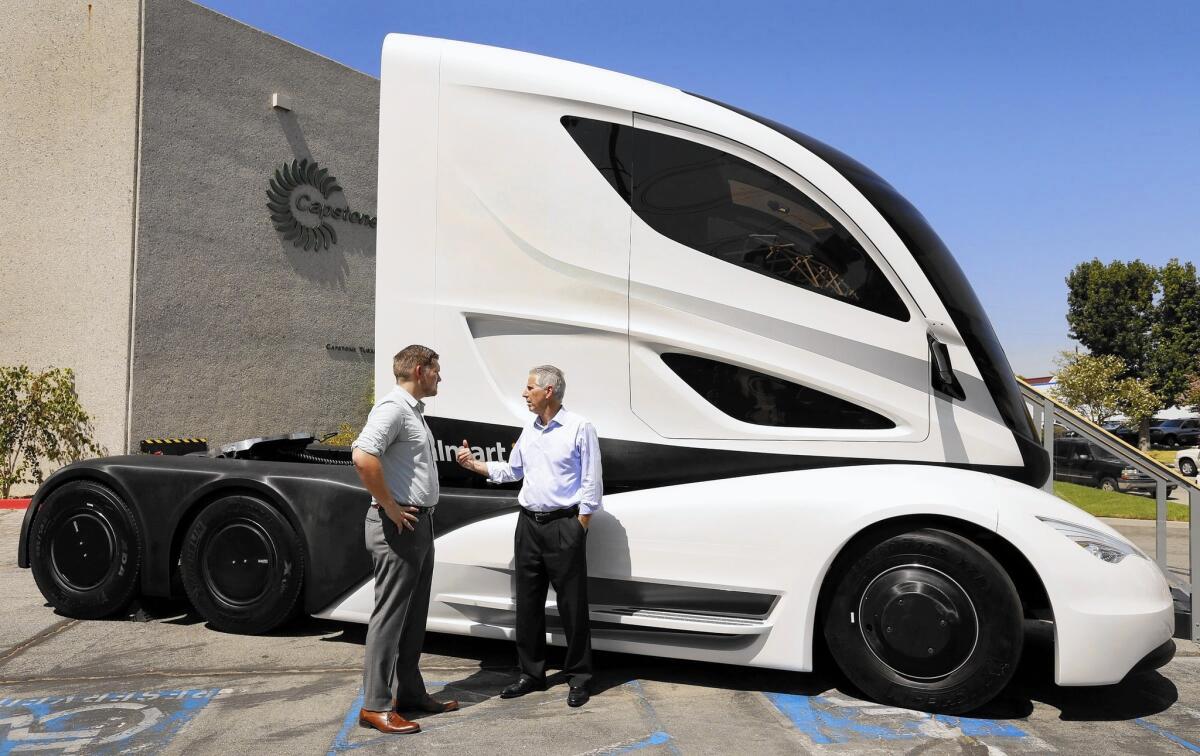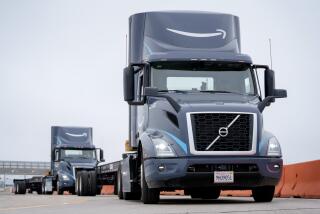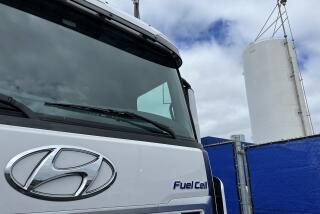Wal-Mart test truck aims to slash fuel consumption on big rigs

A futuristic hybrid-electric tractor-trailer concept truck is parked outside the Capstone Turbine facility in Chatsworth.
- Share via
If Bruce Wayne ever had to vacate the Batcave, he might insist on moving his Batgear with an arrow sleek microturbine big rig with a carbon-fiber cargo trailer, an electronic dashboard of three computer tablets and tires wider than any race car.
This is WAVE, the Wal-Mart Advanced Vehicle Experience concept truck, a collaboration of 22 international companies. It’s also a rolling stock test case for technologies that could revolutionize the way freight is hauled on roads.
The collaboration began when Wal-Mart approached several firms in January 2011. One was the maker of a heavily patented microturbine motor small enough to fit under the hood of a heavy-duty freight hauler.
“Wal-Mart said they were looking for the truck of the future,” recalled Darren R. Jamison, president and chief executive of Capstone Turbine Corp. in Chatsworth.
“They didn’t want what the technology could look like next year,” Jamison said. “They wanted to look at where it could be five years or 10 years from now.”
Brent Hankins, an advanced concepts engineer at truck manufacturer Peterbilt Motors Co., said growing demand for new solutions was also driving projects like the Wal-Mart concept truck.
“Now that we are seeing more customer demand for hybrid-electric technology” in medium- to heavy-duty trucks, he said, “we are starting to look at those range-extending possibilities, such as the microturbine.”
Three powerful incentives are driving this push for innovation. One is the price of trucking goods to and from destinations across the U.S.
In 2014, the American Trucking Assns. said that the industry spent an estimated $147 billion on fuel.
Even with oil prices running at some of their lowest levels since 2009, the ATA said the industry is still on pace to spend about $105 billion in 2015. Moreover, no one expects oil prices to remain below $50 a barrel, not when it was nearly three times higher just seven years ago.
“Fuel is usually our first- or second-largest expense, along with labor costs,” said Sean McNally, a spokesman for the trucking associations. That means more efficient trucks and “reducing fuel expenditures would be a huge benefit to trucking and to the economy.”
The second issue is environmental. Advances in conventional engines have reduced emissions over the last seven years, but “the areas around seaports” and the freight corridors that lead to warehouse and distribution centers “still have some of the worst air quality in the nation,” said Luke Tonachel, director of the National Resources Defense Council’s Clean Vehicles and Fuels Project.
And the demand for even lower emissions is on the horizon. The Obama administration has proposed performance standards for medium- to heavy-duty trucks and tractor trailers with a goal of reducing emissions by 1 billion metric tons and oil use by 1.8 billion barrels.
Wal-Mart estimates that its WAVE concept truck will reduce fuel consumption by 55% over long routes and by 241% over shorter routes, when its microturbine and electric motor can be put to best use.
Microturbines can be thought of as miniature windmills in the way that they operate and generate power. The blades, the only moving parts of these machines, spin at 96,000 revolutions per minute. The turbine sucks in air and heats it to temperatures in excess of 1,500 degrees Fahrenheit. The heated air rapidly expands, spinning the turbine’s blades. Some of that mechanical energy is used to power the turbine itself; the rest can be used to run a generator.
Capstone’s technology, which is protected by 112 patents, presents several advantages. First, it can be run on many kinds of fuel, including diesel, natural gas and propane. Second, the technology uses so-called air bearings, eliminating the need for metal ball bearings, which require lubrication and replacement. The microturbines are also air-cooled, eliminating the need for a large radiator and antifreeze.
The truck’s cab is more aerodynamic, Peterbilt’s Hankins said, “in part because there was no need for a large radiator. The driver’s position has been moved to the center of the cabin, rather than on the left side, to help make it more streamlined.”
Capstone’s Jamison said it operates “like a Chevy Volt,” which uses battery power exclusively for about 30 miles until the charge runs out. That’s when the microturbine kicks in to recharge the battery and extend the truck’s range.
Great Dane Trailers of Fontana, Fiber-Tech Industries Inc. of Michigan and Milliken & Co. of South Carolina combined to build the 53-foot-long carbon-fiber trailer held together by advanced adhesives and reduced the weight to just 10,000 pounds, compared with 14,000 pounds for a typical trailer.
The WAVE truck will not be reproduced on a mass scale. As a concept vehicle, it is showcasing many technologies, making it prohibitively expensive. Peterbilt’s Hankins said the truck, as is, would be in excess of $300,000, at least three times as expensive as conventional big rigs. Wal-Mart hasn’t commented on the cost of the WAVE truck.
Although the microturbine technology has proved reliable as a stationary power source in hotels, hospitals and other kinds of buildings, it is still in the trial stages as a vehicle engine.
A Kenworth truck with a Capstone microturbine is undergoing trials. Another test is being conducted at the Port of Los Angeles.
Some of the companies involved in the project, such as Allison Transmission and Roush Enterprises, are frequently involved in concept vehicles and also produce aftermarket modifications to factory-built vehicles.
But Capstone has another reason to be involved. Although its microturbines are sold around the world, it has yet to have a profitable year since it went public 15 years ago. Jamison said it is tough to compete with traditional and alternative energy sources, such as solar power.
“We are hoping to bring more attention to what we do with our main business,” Jamison said on a day when the truck was parked outside Capstone’s Chatsworth offices, drawing considerable attention from motorists, some of whom stopped to ask what it was. One guess: It was a prop for a new Transformers movie. “We are hoping it brings us some more clients.”
Twitter: @RonWLATimes
ALSO
After driving for Uber, he’s keeping his day job
VW cheated on U.S. pollution tests for ‘clean diesels’
West Valley welcomes upscale shopping village, but don’t call it a mall
More to Read
Inside the business of entertainment
The Wide Shot brings you news, analysis and insights on everything from streaming wars to production — and what it all means for the future.
You may occasionally receive promotional content from the Los Angeles Times.











